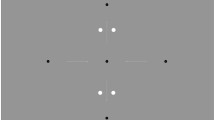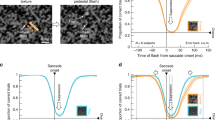Abstract
In the global effect, saccades are displaced towards a distractor if the latter is near to the target, an effect thought to reflect spatial averaging in neurons of the superior colliculus. The temporal dynamics of the global effect have not been well studied, however. We had twelve subjects perform horizontal saccades to a target in trials in which there were either no distractor or a distractor stimulus located 20° above or below the target. The distractor appeared either simultaneously with the target or preceded it by an interval of between 100 and 800 ms, and was either flashed for only 100 ms or remained visible until the subject responded with a saccade. Both flashed and persistent distractors reduced saccadic latency if they preceded target onset, indicating that subjects could use this cue to prepare saccades in advance. Saccadic endpoint was displaced towards a flashed distractor only if it was simultaneous with the target. However, persistent distractors produced a global effect for both simultaneous presentation and distractor–target intervals of 100 ms, but not for longer intervals. We conclude that the global effect requires of the distractor both a recent onset and persistence of the distractor, and that distractor-related activity decays rapidly within 300 ms.





Similar content being viewed by others
References
Anderson RW, Keller EL, Gandhi NJ, Das S (1998) Two-dimensional saccade-related population activity in superior colliculus in monkey. J Neurophysiol 80(2):798–817
Coren S, Hoenig P (1972) Effect of non-target stimuli upon length of voluntary saccades. Percept Mot Skills 34(2):499–508
Eggert T, Sailer U, Ditterich J, Straube A (2002) Differential effect of a distractor on primary saccades and perceptual localization. Vis Res 42(28):2969–2984. doi:10.1016/S0042-6989(02)00392-9
Everling S, Dorris MC, Klein RM, Munoz DP (1999) Role of primate superior colliculus in preparation and execution of anti-saccades and pro-saccades. J Neurosci 19(7):2740–2754
Findlay JM (1982) Global visual processing for saccadic eye movements. Vis Res 22(8):1033–1045. doi:10.1016/0042-6989(82)90040-2
Findlay JM (1997) Saccade target selection during visual search. Vis Res 37(5):617–631
Findlay JM, Gilchrist ID (1997) Spatial scale and saccade programming. Perception 26(9):1159–1167
Glimcher PW, Sparks DL (1993) Representation of averaging saccades in the superior colliculus of the monkey. Exp Brain Res 95(3):429–435
Guitton D, Bergeron A., Choi WY (2004) On the role of subcortical feedback mechanisms in the control of head-unrestrained gaze saccades. In: Hall W, Moschovakis A (Eds) The superior colliculus: new approaches for studying sensorimotor integration, CRC Press LLC, USA
Herwig A, Beisert M, Schneider WX (2010) On the spatial interaction of visual working memory and attention: evidence for a global effect from memory-guided saccades. J Vis 10(5):8. doi:10.1167/10.5.8
Lévy-Schoen A (1969) Determination et latence de la response oculomotrice a deux stimulus. L’Anee Psychol 74:43–66
Meeter M, Van der Stigchel S, Theeuwes J (2010) A competitive integration model of exogenous and endogenous eye movements. Biol Cybern 102(4):271–291. doi:10.1007/s00422-010-0365-y
Moschovakis AK., Scudder CA, Highstein SM (1996) The microscopic anatomy and physiology of the mammalian saccadic system. Prog Neurobiol 50:133–254
Munoz DP, Wurtz RH (1995a) Saccade-related activity in monkey superior colliculus. I. Characteristics of burst and buildup cells. J Neurophysiol 73(6):2313–2333
Munoz DP, Wurtz RH (1995b) Saccade-related activity in monkey superior colliculus. II. Spread of activity during saccades. J Neurophysiol 73(6):2334–2348
Ottes FP, Van Gisbergen JA, Eggermont JJ (1985) Latency dependence of colour-based target vs nontarget discrimination by the saccadic system. Vis Res 25(6):849–862
Trappenberg TP, Dorris MC, Munoz DP, Klein RM (2001) A model of saccade initiation based on the competitive integration of exogenous and endogenous signals in the superior colliculus. J Cogn Neurosci 13(2):256–271
Van der Stigchel S, de Vries JP, Bethlehem R, Theeuwes J (2011) A global effect of capture saccades. Exp Brain Res 210(1):57–65. doi:10.1007/s00221-011-2602-6
van Opstal AJ, van Gisbergen JA (1989) Scatter in the metrics of saccades and properties of the collicular motor map. Vis Res 29(9):1183–1196
Viswanathan J, Barton JJ (2012) The global effect for antisaccades. Exp Brain Res. doi:10.1007/s00221-012-3366-3
Walker R, Deubel H, Schneider WX, Findlay JM (1997) Effect of remote distractors on saccade programming: evidence for an extended fixation zone. J Neurophysiol 78(2):1108–1119
Acknowledgments
This work was supported by CIHR operating grant MOP-81270. JB was supported by a Canada Research Chair and the Marianne Koerner Chair in Brain Diseases.
Author information
Authors and Affiliations
Corresponding author
Ethics declarations
Conflict of interest
The authors declare that they have no conflict of interest.
Rights and permissions
About this article
Cite this article
Choi, W.Y., Viswanathan, J. & Barton, J.J.S. The temporal dynamics of the distractor in the global effect. Exp Brain Res 234, 2457–2463 (2016). https://doi.org/10.1007/s00221-016-4650-4
Received:
Accepted:
Published:
Issue Date:
DOI: https://doi.org/10.1007/s00221-016-4650-4




